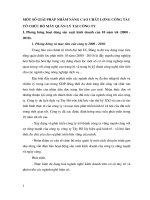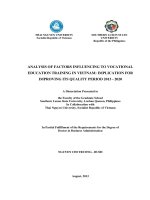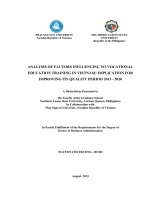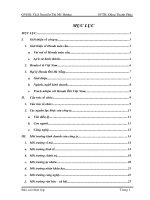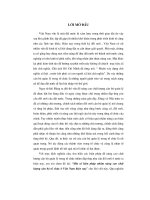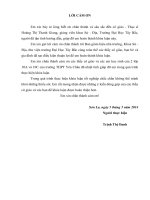Some suggestions to improve current account service enhancement at Techcombank = Một số đề xuất nhằm nâng cao chất lượng cung cấp dịch vụ tài khoản thanh toán cá nhân tại Techcombank
Bạn đang xem bản rút gọn của tài liệu. Xem và tải ngay bản đầy đủ của tài liệu tại đây (4.99 MB, 110 trang )
VIETNAM NATIONAL UNIVERSITY, HANOI
SCHOOL OF BUSINESS
PHUNG THI PHUONG THAO
SOME SUGGESTIONS TO IMPROVE
CURRENT ACCOUNT SERVICE ENHANCEMENT
AT TECHCOMBANK
Major: Business Administration
Code: 60 34 05
MASTER OF BUSINESS ADMINISTRATION THESIS
Supervisors: Dr. Tran Doan Kim
Ha Noi, 2012
ii
ABSTRACT
SOME SUGGESTIONS TO IMPROVE
CURRENT ACCOUNT SERVICE ENHANCEMENT AT TECHCOMBANK
Phung Thi Phuong Thao
MBA candidate, ReMBA8
Viet Nam National University, Ha Noi.
School of Business
Supervisors: Dr. Tran Doan Kim
December, 2012, 101 pages
Current Account (CA) is a very important and indispensable meant for not
only industrialists, firms, enterprises etc but also for individual customers,
who have demand of banking transactions on a daily basis.
Customers use their CA neither for the purpose of earning interest nor for the
purpose of savings, but only for convenience and comfort of the business. The
CA interest rate, hence, is quite low or event equal to zero.
The balance from CA, then, becomes a low-price and significant source for
banks. CA is bringing 10 times profit higher than savings and time deposits;
about 2.5 – 4 times higher than loan in NII index.
Also, as showed in some studies, customers tend to chose bank with their
inflow and outflow of CA to be primary bank to have other bank’s service
relationships. Therefore, banks are focusing on developing current account to
be the champion product in market expanding strategy.
In Vietnam, as information from Vietnam Card Association, there are about
iii
20 million people, mainly in cities, joining current account services. It makes
the urban market which contributing up to 70-80% income and profit from
current account, almost saturated.
It is estimated that “acquiring new customer can cost five times more than the
cost of satisfying and retaining current customers” (Philip Kotler, 2001).
From this fact, banks are now paying more attention to improve services to
satisfy customer who become harder and harder to please.
The thesis focuses on discovering deeply insides individual customer using
current accounts, what the factors of satisfaction are and giving out some
initiatives of customer satisfaction improvement.
vi
TABLE OF CONTENTS
ACKNOWLEGEMENT i
ABSTRACT ii
TÓM TẮT iv
TABLE OF CONTENTS vi
LIST OF TABLES ix
LIST OF FIGURES xi
CHAPTER 1 LITERATURE REVIEW 1
1.1 CUSTOMER REALATIONSHIP MANAGEMENT 1
1.1.1 Definition 1
1.1.2 IDIC: Four implementation tasks for creating and managing customer
relationships. 2
1.2 CUSTOMER SATISFACTION 4
1.2.1. Definition 4
1.2.2. The role of expectations and perceptions 5
1.2.2. Service quality and GAP model 6
CHAPTER 2 TECHCOMBANK CASE STUDY 19
2.1 TECHCOMBANK AND CURRENT ACCOUNT SERVICES 19
2.1.1 Techcombank overview 19
2.1.2 Techcombank current account strategy and ambitious plan to 2014 26
2.1.2 Techcombank current account’s performance 28
2.2 A REVIEW OF TECHCOMBANK’S CUSTOMER RELATIONSHIP
MANAGEMENT 30
vii
2.2.1 CRM department 30
2.2.2 CRM in process 31
2.3 A REVIEW OF TECHCOMBANK’S SURVEY ON CURRENT
ACCOUNTS SERVICE 31
2.3.1 Survey objective 31
2.3.2 Focus group 33
2.3.3 Quantitative survey on customer satisfaction 36
2.3.4 Quantitative survey on customer satisfaction 43
CHAPTER 3: FINDINGS 45
3.1 CRM ACTIVITIES 45
3.2 CUSTOMER GAP ANALYSIS 46
3.3 PROVIDER GAP ANALYSIS 48
3.3.1 Not knowing what customers expect and not selecting the right service
designs and standards 48
3.3.2 Not delivering to service designs and standards and not matching
performance to promises 50
CHAPTER 4: RECOMMENTATION 56
4.1 INTERNAL TRANING AND COMMUNICATION 56
4.2 KPIs AND SALES ORIENTATION 57
4.3 ENHANCE SERVICE STANDARDZATION 58
4.4 IMPROVEMENT PROCEDURE TO REDUCE SERVING TIME 59
4.5 DEVELOP ALTERNATIVE CHANNEL TO REDUCE OTC WORKLOAD
60
4.6 PRODUCT DESIGN 60
viii
4.7 PAYROLL FORCUS 61
4.8 CRM ENHANCEMENT 63
QUESTIONNAIRE 65
REFERENCES 97
ix
LIST OF TABLES
Table 2.1: Techcombank current account portfolio to 2014 27
Table 2.2 : Techcombank CA NIM performance 28
Table 2.3 : Techcombank CA multiple-service Customer ratio 29
Table 2.4 : Techcombank CA’s balance portfolio by products 30
Table 2.5 : Prompt responses to customers’ requests 34
Table 2.6 : Customer satisfaction on Enthusiastic bank staff 34
Table 2.7 : Product structure to fulfill customer needs 35
Table 2.8 : Effective added services 35
Table 2.9: Survey Systematic Sampling – Single Product user 37
Table 2.10: Survey Systematic Sampling – Multiple-Product users 37
Table 2.11: Feedback on customer choice (%) 38
Table 2.11: Other banking services using (%) 38
Table 2.12: Which offer will do customers interested in opening ATM card or
registering for internet banking with TCB? 38
Table 2.13: Feedback on CA opening and services registered procedure (%) 39
Table 2.14: Feedback on card issuance time (%) 39
Table 2.15: Feedback on Token key issuance time (%) 40
Table 2.16: Customer’ first Chanel chosen 40
Table 2.17: Prompt responses to customers’ requests 40
Table 2.18: Satisfaction level with “Enthusiastic bank staff” 41
Table 2.19 : Product structure to fulfill customer needs 41
Table 2.20 : Effective added services 42
x
Table 2.20 : What factor influences customer to start using a CA ? 42
Table 2.21 : Which factor decide the main bank ? 43
Table 3.1: Data ware-house status 45
Table 3.2: Data avalable sources 46
Table 3.3 : GAP on customer satisfation 48
Table 3.4 : Complaint management 54
Table 3.5 : Sales force activities 55
xi
LIST OF FIGURES
Finger 1.1: IDIC: Analysis and Action (Peppers and Rogers, 2004) 4
Finger 1.2: GAP Model (Parasuraman, A., Zeithaml, V.A. and Berry, L.L, 1991) 7
Finger 1.3: Provider Gap 1 (Parasuraman, A., Zeithaml, V.A. and Berry, L.L, 1991) 9
Finger 1.4: Provider Gap 2 (Parasuraman, A., Zeithaml, V.A. and Berry, L.L, 1991) 10
Finger 1.5: Provider Gap 3 (Parasuraman, A., Zeithaml, V.A. and Berry, L.L, 1991) 12
Finger 1.6: Provider Gap 4 (Parasuraman, A., Zeithaml, V.A. and Berry, L.L, 1991) 14
Finger 2.1: Current account key proposition [TCB, 2011-2014 strategy] 27
Finger 4.1: Sales model [R&D department, PFS action 2013 plan] 58
Finger 4.2: Customer interactions procedure [TCB, 2011-2014 strategy] 59
Finger 4.2: Product design [R&D department, PFS action 2013 plan] 61
Finger 4.3: Cross-sell process [R&D department, PFS action 2013 plan] 62
Finger 4.4: CRM Capabilities will be mapped [R&D department, PFS action 2013 plan] 63
Finger 4.4: CRM assessment Approach [R&D department, PFS action 2013 plan] 64
1
CHAPTER 1: LITERATURE REVIEW
This chapter reviews literature relating to the research questions and
hypotheses of this study. First, the chapter begins with a summary of
customer relationship management (CRM); then, the relationships of four
implementation tasks for creating and managing customer relationships.
Finally the definition of customer satisfaction and the impact of factor on
customer satisfaction are provided.
1.1 CUSTOMER REALATIONSHIP MANAGEMENT
1.1.1 Definition
Customer Relationship Management (CRM) is “a set of business practices
designed, simply, to put an enterprise into closer and closer touch with its
customers, in order to learn more about each one, with the overall goal of
making each one more valuable to the firm” (Don Pepper & Martha Rogers,
2004).
In a simple world, CRM is a tool helping an enterprise to set up and manage
individual customer relationships.
The CRM is also known by other terms such as integrated marketing
communication (Don Schultz), one-to-one relationship management (Don
Peppers & Martha Rogers), real time marketing (Regis Mc Kenna), customer
intimacy (Michael Treacy & Fred Wiersema)…
“CRM is more than just an outgrowth of direct marketing and the
advent of new technology. It requires new skills, systems, processed
and employee mindsets (Philip Kotler, 2001).”
The central purpose of CRM are setting up and operating us for the enterprise
to focus on increasing the value of customer base, whether through cross-
selling (getting customers to buy other products or services) or up-selling
2
(getting customers to buy more expensive offerings)
1.1.2 IDIC: Four implementation tasks for creating and managing
customer relationships.
Setting up and managing individual customer relationships can be broken up
into four interrelated implementation tasks: identifying, differentiating,
interacting with and customizing treatment.
Identify customer
The first task in setting up a relationship is to identify, individually, the party
of the relationship as much detail as possible. An enterprise must have an
ability to recognize a customer when he comes back in person, directly, by
phone, online or whatever.
Differentiate customers
Customer represents different level of value to the enterprise, therefore, they
requires differently from the enterprise. Grouping customer bases on specific
variable allows a company (1) to focus its resources on the most value
customer groups, and (2) design and control customer-specific strategies of
products, services enhancement.
Interact with customer
Enterprise must improve the effectiveness of their interactions with
customers. Instead of talking to customer with whatever dialog, the company
should continue with prior communication if it has occurred before.
Customize treatment
Base on individual’s needs and value, the enterprise should adapt some aspect
of its behavior toward a customer. This customization could involve the way a
newsletter is rendered or how a product is bundled.
3
Treating different customer differently could be very expensive if every
interaction and transaction had to be individually adapted. Many enterprises
are now using a technique of mass customization.
“A mass customizer actually does is not customization, but configuration.
The mass customizer pre-produces a dozens, or hundreds, of “modules”, for a
product, and/or its related services, delivery options, payment plants, and the
like. Then, base on an individual customer’s needs, the company puts
different modules together to yield thousands, or even millions, of possible
product configuration (Don Pepper & Martha Roger & Bob Dorf, 1999).”
The biggest obstacle is ensuring that different parts actually work with one
another and can be fit together easily.
The implementation of the IDIC methodology can be broken down into two
categories: analysis and action
4
Finger 1.1: IDIC: Analysis and Action (Peppers and Rogers, 2004)
1.2 CUSTOMER SATISFACTION
1.2.1. Definition
Customer satisfaction, a term frequently used in Marketing and product R&D,
is a measure of how a product or service meet or surpass customer
expectation.
Satisfaction is a widely accepted concept despite real difficulties in measuring
and interpreting. The most common approach is the use of general satisfaction
surveys undertaken every few years and designed to track changes over time.
5
There are however, a number of difficulties with the concept of satisfaction
(Communities Scotland, 2006):
“It is not static, but changes over time; new experiences and levels of
awareness will alter the potential levels of satisfaction that could be
achieved.
It is likely to be complex and the result of a mix of experiences before,
during and after the point at which it is measured.
It occurs in social contexts which are varied and changing and may be
unpredictable or inexpressible to the service user.
It may be difficult to express the reasons for satisfaction; particularly
where less tangible aspects of services are being considered.
It may be easier to express the reasons for dissatisfaction, particularly if
this is the exceptional state.”
In order to get a better view on satisfaction, we describe some key elements in
this part. If experience of the service greatly exceeds the expectations clients
had of the service, then satisfaction will be high, and vice versa. In the service
quality literature, perceptions of service delivery are measured separately
from customer expectations, and the gap between the two, P (perceptions) – E
(expectations), provides a measure of service quality and determines the level
of satisfaction (Parasuraman, A., Zeithaml, V.A. and Berry, L.L, 1991).
1.2.2. The role of expectations and perceptions
Customer expectation is the main element influencing customer satisfaction.
It is important to understand how they are formed. The basic key factors most
commonly seen to influence expectation are:
Personal need
Any customer or user of a service will have what they consider as a set of key
personal needs that they expect from the service. These will vary from service
to service and from customer to customer. A clear understanding of these
needs is necessary to design an appropriate service.
Previous experience
6
Many customers will have had experience of using services before. This
previous experience will influence their future expectation of the service. This
can include their past experience of a similar services.
Word of mouth communications
Expectation of customer may be influenced by other sources other than the
service provider itself. Family, friends, colleagues, media…also influence in
customer expectation shaping.
Explicit service communications.
Statements from leaflets or other publicity material can have a direct impact
on expectation.
Implicit service communication.
This includes factors such as: the physical appearance of the building, well
lighted parking lot…which customer may sense only vaguely.
The overall model of key factors influencing expectation of public services is
widely recognized that the nature and impact of each of these influences will
vary for different customers and services. This is not an additional
determinant of expectations in the same way as those outlined above, but it is
critical to understand when making comparisons between public services: for
some services, the greatest influence on the level of expectations is likely to
be the nature of the customer group that is being served.
1.2.2. Service quality and GAP model
As described above, the service quality model starts from the basic gap
between P (perception) – E (Expectation).
Service quality gap model has been divided by 2 parts: Customer gap and
provider gap.
7
Finger 1.2: GAP Model (Parasuraman, A., Zeithaml, V.A. and Berry, L.L,
1991)
Customer Gap
The customer gap is the difference between customer expectation and
perceptions (Figure 1.2). Customer expectations are standards or reference
points that customers bring into the service experience, whereas customer
perceptions are subjective assessments of actual service experiences.
Gap closed to zero or perception service similar to expectation is perfect
thing, but Companies tend to close customer gap to develop.
Provider Gaps
To close the all important customer gap, the gaps model suggests that
provider gaps need to be closed. These gaps occur within the organization
providing the service and include four gaps:
Gap 1: Not knowing what customers expect.
Gap 2: Not selecting the right service designs and standards.
8
Gap 3: Not delivering to service designs and standards.
Gap 4: Not matching performance to promises.
More details of these gaps are provided below:
Gap 1: Not knowing what customers expect.
Gap 1 defines the difference between customer expectations of service and
company understanding of those expectations.
There are many reasons for managers not being aware of what customers
expect: they may not interact directly with customers, they may be unwilling
to ask about expectations or they may be unprepared to address them, also
they may image all customers are similar to themselves. These will lead to
bad decisions and unreasonable resource allocation that result in perception of
poor service quality.
When management or empowered employees do not acquire accurate
information about customers’ expectations, provider gap 1 is large. Formal
and informal methods to capture information about customer expectations
must be developed through marketing research.
9
Finger 1.3: Provider Gap 1 (Parasuraman, A., Zeithaml, V.A. and Berry,
L.L, 1991)
Gap 2: Not having the right service quality designs and standards.
Gap 2 focuses on difference between company understanding of customer
expectations and development of customer-driven service designs and
Customer expectation
Inadequate marketing research orientation
Insufficient marketing research
Research not focused on service quality
Inadequate use of market research
Lack of upward communication
Lack of interaction between management and
customers
Insufficient communication between contact
employees and managers
Too many layers between contact personnel
and top management
Insufficient relationship focus
Lack of market segmentation
Focus on transactions rather than relationships
Focus on new customers rather than
relationship customers
Inadequate service recovery
Lack of encouragement to listen to customer
complaints
Failure to make amends when things go wrong
No appropriate recovery mechanisms in place
for service failures
Company perception of
customer expectation
G
A
P
1
10
standards.
Finger 1.4: Provider Gap 2 (Parasuraman, A., Zeithaml, V.A. and Berry,
L.L, 1991)
Because services are intangible, they are difficult to describe and
communicate. This difficulty becomes especially evident when new services
are being developed. It is critical that all people involved (managers, front
Customer-Driven Service
Designs and Standards
Poor service design
Unsystematic new service development
process
Vague, undefined service designs
Failure to connect service design to service
positioning
Absence of customer-driven standards
Lack of customer-driven service standards
Absence of process management to focus on
customer requirements.
Absence of formal process for setting service
quality goals.
Inappropriate physical evidence and
services cape
Failure to develop tangibles in line with
customer expectations
Servicescape design that does not meet
customer and employee needs
Inadequate maintenance and updating of the
servicescape
Not appropriate recovery mechanisms
Management Perceptions
of Customer Expectations
G
A
P
2
11
officer, and back officer) be working with the same concepts of the new
services, based on customer needs and expectations. For a service already
exists, any attempt to improve it will also suffer unless everyone has the same
vision of the service and associated issues.
One of the most important ways to avoid gap 2 is to clearly design service
without oversimplification, incompleteness, subjectivity, and bias. To do so,
tools are needed to ensure that new and existing services are developed and
improved in as careful a manner as possible.
The quality of services delivered by customer contact personnel is critically
influenced by the standards against which they are evaluated and
compensated. Standard signals to contact personnel what the management
priorities are and which types of performance really count. When service
standards are absent or when standards in place do not reflect customer
expectations, quality of services they receive s likely to be enhanced. If
service standards are developed appropriately they can have powerful positive
impact on closing both gap 1 and customer gap.
Gap 3: Not delivering to service designs and standards.
Gap 3 is discrepancy between development of customer-driven service
standards and actual service performance by company employees.
12
Finger 1.5: Provider Gap 3 (Parasuraman, A., Zeithaml, V.A. and Berry,
L.L, 1991)
Even when guidelines exist for performing services well and treating
customers correctly, high-quality service performance is not certainty.
Standards must be backed by appropriate resources (people, systems, and
technology) and also must be enforced to be effective – that is, employees
Customer-Driven Service
Designs and Standards
Deficiencies in human resource policies
Ineffective recruitment
Role ambiguity and role conflict
Inappropriate evaluation and compensation
systems
Lack of empowerment, perceived control, and
teamwork
Customers who do not fulfill roles
Customers who lack knowledge of their roles
and responsibilities
Customers who negatively impact each other
Problems with service intermediaries
Channel conflict over objectives and
performance
Difficulty controlling quality and consistency
Tension between empowerment and control
Failure to match supply and demand
Failure to smooth peaks and valleys of demand
Inappropriate customer mix
Overreliance on price to smooth demand
Service Delivery
G
A
P
3
13
must be measured and compensated on the basis of performance along those
standards. Thus, even standards accurately reflect customers’ expectations, if
company fails to provide support for those standards – if it does not facilitate,
encourage, and require their achievement – standards do no good. When the
level of service delivery falls short of the standards, it falls short of what
customers expect as well.
Gap 4: Not matching performance to promises
Provider gap 4 illustrates the difference between service delivery and the
service provider’s external communications. Promises bade by a service
company through its media adverting, sales force, and other communications
may potentially raise customer expectations, the standards against which
customers assess service quality. The discrepancy between actual and
promised service therefore has an adverse effect on customer gap.
14
Finger 1.6: Provider Gap 4 (Parasuraman, A., Zeithaml, V.A. and Berry,
L.L, 1991)
Broken promises can occur for many reasons: overpromising in advertising or
personal selling, inadequate coordination between operation and marketing,
and differences in policies and procedures across service outlets.
One of the major difficulties associated with provider gap 4 is that
Service Delivery
Lack of integrated services marketing
communications
Tendency to view each external
communication as independent
Absence of strong internal marketing
program
Ineffective management of customer
expectations
Absence of customer expectation management
through all forms of communication
Lack of adequate education for customers
Overpromising
Overpromising in advertising
Overpromising in personal selling
Overpromising through physical evidence cues
Inadequate horizontal communications
Insufficient communication between sales and
operations
Insufficient communication between
advertising and operations
Differences in policies and procedures across
branches or units
External communications to customers
G
A
P
4
15
communications to customer involve issues that cross organizational
boundaries. Because advertising promises what people do, and because what
people can’t be controlled like machines that produce physical goods can be
controlled, this type of communications involves functions other than the
marketing department. This type of marketing is what we call interactive
marketing – the marketing between contact people and customer – and it must
be coordinated with the conventional type of external marketing used in
product and service firms. When employees who promote service do not fully
understand the reality of service delivery, they are likely to make exaggerated
promises or fail to communicate to customer aspects of the service intended to
serve them well. The result is poor service quality perception. Effectively
coordinating actual service delivery with external communications, therefore,
narrow provider gap 4 and favorably affects customer gap as well.
In summary, service quality is created from all organization’s operation
procedures, and it is measured by how well organization can shorten its gaps,
included customer gap and provider gaps. The key to close provider gaps is to
close gap 1 through gap 4 and keep them closed.
The full conceptual model in figure 1.6 provides clear message to manager
wishing to improve service quality. The gap model of service quality serves
as a framework for service organizations attempting to improve service
quality and service marketing.
In order to make it easy to define, some organizations put all gap with some
clear main questions and score them, then they can position their quality
service and point out where they have to focus on to improve their service
quality. By this way, Gap model is called Service quality gap model audit.
Service quality gap model audit:
16
Gap
Score
Customer gap:
1. How well does the company understand customer expectations of
service quality?
2. How well does the company understand customer perception of
service?
1 = poor
10 =
excellent
Provider gap 1:
1. Market research orientation.
Is the amount and type of market research adequate to understand
customer expectations of service?
Does the company use this information in decisions about service
provision?
2. Upward communication.
Do managers and customer interact enough for management to know
what customer expect?
Do contact people tell management what customer expects?
3. Relationship focus.
To what extent does the company understand the expectations of
different customer segments?
To what extent does the company focus on relationships with
customer rather than transactions?
4. Service recovery.
How effective are the recovery efforts of organization?
How well does the organization plan for service failure?
1 = poor
10 =
excellent

